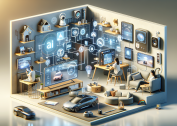Ever imagined how smart home devices could simplify daily routines and save energy? This guide delves into the latest innovations in home automation, voice assistants, energy management, and security solutions. Discover how integrated tech can enhance comfort and efficiency, making everyday living more convenient and connected.
Understanding Smart Home Technology
Smart home technology brings automation into regular households, providing a network of devices that communicate and function together. These systems often revolve around a central voice assistant or mobile app and can handle tasks like lighting, thermostats, alarms, and entertainment. By relying on wireless connectivity, smart home ecosystems are designed to streamline daily routines and make life more manageable.
One hallmark of smart home automation is its adaptability. Users can easily expand a system by integrating additional smart plugs, cameras, or sensors as needs evolve. Compatibility is crucial; major brands work hard to maintain interoperability across different devices, ensuring that consumers aren’t locked into proprietary platforms. This encourages experimentation and innovation in the space.
Another appealing aspect of connected homes is remote management. Imagine adjusting climate settings or monitoring security feeds from anywhere with internet access. This real-time access fosters peace of mind, while data-driven insights help optimize device use. Collectively, the foundation of smart home technology is about flexibility, control, and seamless living.
Popular Smart Devices Transforming Homes
Voice assistants like Amazon Echo, Google Nest, and Apple HomePod act as the nerve centers of many modern smart homes. They allow hands-free control over lights, thermostats, connected appliances, and media. Integration with third-party services even extends to grocery lists and calendar reminders, making them multipurpose household hubs.
Smart thermostats such as Ecobee and Nest help maintain comfortable indoor climates while promoting energy efficiency. Users can set custom schedules, monitor usage patterns, and even use geofencing to save on bills. These thermostats learn habits over time and self-adjust, providing convenience and potential energy cost savings.
Indoor and outdoor cameras, smart locks, and motion sensors bolster home security. Devices like Ring Video Doorbell or Arlo cams offer two-way communication, real-time alerts, and remote monitoring. For many, the combination of visual oversight, automation, and data storage is integral to feeling safe.
Energy Management with Smart Solutions
Energy-efficient smart plugs and power strips provide users with the ability to remotely control and schedule electronics. By shutting off idle appliances or optimizing charging routines, these devices reduce unnecessary power draw. Individual appliance monitoring helps users understand their actual energy usage, leading to better decisions and environmental benefits.
Smart thermostats and lighting contribute significantly to lowering overall household energy usage. LED smart bulbs can be scheduled, dimmed, or triggered by environmental sensors—ensuring illumination only when required. Smart climate systems adjust heating and cooling based on occupancy and weather trends, optimizing comfort without excess consumption.
Real-time analytics empower homeowners to identify energy drains and adapt accordingly. For instance, sunrise and sunset automations help create natural daily lighting schedules, and seasonal programming tailors HVAC operations. Collectively, these technologies help people manage costs and reduce their environmental impact, engaging a growing movement toward sustainability.
Smart Security Enhancements for Peace of Mind
Security is a leading motivator for adopting smart home systems. From entry sensors to HD doorbell cameras, real-time notifications keep residents informed of any activity. Many systems seamlessly integrate with traditional alarms, providing a comprehensive approach to household safety.
Remote access is a game changer. Users can lock or unlock doors, view camera feeds, and communicate with visitors from their smartphones. Some smart locks allow digital keys for guests, while others include tamper detection and automated locking features. These innovations add layers of convenience and control to everyday living.
Cloud-enabled storage ensures security footage is accessible and backed up, which is particularly useful for evidence in case of incidents. Notifications are highly customizable, so only truly relevant events reach the user. Personalized security routines further automate lighting and alarm triggers, helping deter unwanted visitors.
The Future of Smart Home Integration
The future is increasingly about device interoperability and smarter AI-driven automation. Industry efforts are focusing on standards like Matter, which aims to simplify connections and ensure consistency across brands and products. This unification is expected to reduce setup hassles and promote greater accessibility for everyone.
Machine learning is making home automation more predictive and user-focused. Instead of following rigid programming, modern devices are learning routines, preferences, and even responding to contextual triggers like local weather. Such personalization brings unprecedented comfort and intuitive control to daily living spaces.
Looking ahead, the intersection of home automation with health monitoring, renewable energy, and even smart appliances will further enhance home environments. As privacy and security concerns are addressed with stronger standards, more households will likely embrace the potential for an interconnected and responsive home experience.
Overcoming Challenges and Considerations
Despite its promise, smart home technology isn’t without challenges. Initial setup can be complex, particularly with legacy wiring or older infrastructure. Several consumers express worry over device compatibility, fearing systems may not communicate seamlessly across brands or models.
Privacy and data protection remain at the forefront of public discussion. Consistent firmware updates, encrypted communications, and responsible management of user data are critical for building trust. Industry standards continue to evolve with a focus on user rights and transparency regarding what data is collected and how it is used.
Cost is another factor—while entry points like smart bulbs are affordable for many, comprehensive systems with multipoint sensors and premium integrations can carry higher price tags. Consumers are encouraged to scale their technology adoption according to personal needs and budget, starting simple and expanding as comfort grows.
References
1. U.S. Department of Energy. (n.d.). Smart Home Energy Management. Retrieved from https://www.energy.gov/energysaver/save-electricity-and-fuel/home-energy-management-systems
2. Consumer Reports. (n.d.). Smart Home Guide. Retrieved from https://www.consumerreports.org/smart-home/
3. CISA. (2023). Security Risks of Smart Home Devices. Retrieved from https://www.cisa.gov/news-events/alerts/2023/01/10/understanding-and-securing-your-home-network
4. International Energy Agency. (2023). The role of smart homes in energy transition. Retrieved from https://www.iea.org/reports/digital-energy
5. The National Renewable Energy Laboratory. (2021). Smart Home Integration and Interoperability. Retrieved from https://www.nrel.gov/docs/fy21osti/77559.pdf
6. Wired. (n.d.). How to Make Smart Homes Secure. Retrieved from https://www.wired.com/story/how-to-make-smart-homes-secure/









